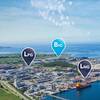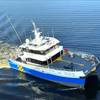Maersk Tankers, HHI & DNV Joint CO2 Ship Design
Maersk Tankers, Hyundai Heavy Industries (HHI) and Det Norske Veritas (DNV) have agreed to collaborate on the design and risk assessment of tankers for shipping CO2.
Maersk Tankers is already in a partnership with Maersk Oil and Finnish utilities Fortum and Teollisuuden Voima (TVO), aimed at developing a joint carbon emissions abatement project in the area of Carbon Capture and Storage (CCS).
“Shipping CO2 in tanker vessels is a cost effective and flexible way to get CO2 from power plants to offshore storage sites, which makes it a suitable solution for large CO2 emission sources such as coal-fired power plants, especially in the emerging phase of CCS.” says Anders Schulze, Head of CO2 Shipping in Maersk Tankers.
Maersk Tankers and HHI already have the initial blueprints to build tanker vessels for the transport of CO2 from emission sources to storage sites. The vessels will be semi-pressurised and semi-refrigerated, keeping the CO2 liquid. HHI has designed the vessels together with Maersk Tankers, based on years of experience with transportation of liquefied petrochemicals and natural gas, and in accordance with global standards.
“The further development of the CO2 carrier design shall mainly focus on the safety and the Green ship requirements while emphasising the high energy efficiency of the vessel. HHI’s technical cooperation with Maersk Tankers and DNV explains well HHI’s policy of constant pursuit of new technology and also its dedication to finding solutions to the environmental issues in the shipbuilding segment.” says Mr. Jae Keun Ha, Senior Vice President of HHI.
DNV will provide feasibility studies, risk identification in addition to general support for compliance with applicable class Rules and the current Gas Carrier Code as well as its latest developments specifying CO2 in more detail. These tasks will also include evaluations and support to ensure that the vessel is fit for purpose and fits well into the specific CCS chain.
“The overall technical features of these CO2 carriers have similarities with LPG carriers and offshore shuttle tankers. Many of the applicable safety standards to be applied are therefore basically well known. Studies will, however, have to be carried out to ensure that all features and specialities have been adequately addressed and that the vessels’ interface with the rest of the CCS chain is in harmony with the intentions.” says Jan Koren, DNV’s Segment Director Tankers.













